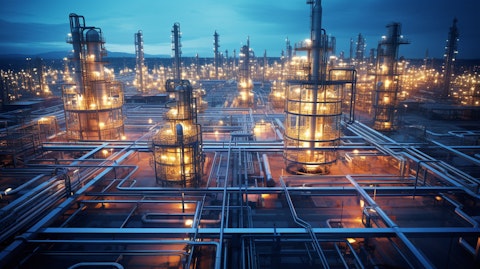Methanex Corporation (NASDAQ:MEOH) Q4 2023 Earnings Call Transcript February 1, 2024
Methanex Corporation isn’t one of the 30 most popular stocks among hedge funds at the end of the third quarter (see the details here).
Operator: Good morning. My name is Dennis, and I will be your conference operator today. At this time, I would like to welcome everyone to the Methanex Corporation 2023 Fourth Quarter Results Conference Call. All lines have been placed on mute to prevent any background noise. After the speakers’ remarks, there will be a question-and-answer session. [Operator Instructions] Thank you. I would now like to turn the conference call over to the Director of Investor Relations at Methanex, Ms. Sarah Herriott. Please go ahead, Ms. Herriott.
Sarah Herriott: Thank you. Good morning, everyone. Welcome to our fourth quarter 2023 results conference call. Our 2023 fourth quarter news release, management’s discussion and analysis and financial statements can be accessed from the reports tab of the Investor Relations page on our website at methanex.com. I would like to remind our listeners that our comments and answers to your questions today may contain forward-looking information. This information, by its nature, is subject to risks and uncertainties that may cause the stated outcome to differ materially from the actual outcome. Certain material factors or assumptions were applied in drawing the conclusions for making the forecasts or projections, which are included in the forward-looking information.
Please refer to our fourth quarter 2023 MD&A and our 2022 annual report for more information. I would also like to caution our listeners that any projections provided today regarding Methanex’s future financial performance are effective as of today’s date. It is our policy not to comment on or update this guidance between quarters. For clarification, any references to revenue, EBITDA, adjusted EBITDA, cash flow, adjusted income, or adjusted earnings per share, made in today’s remarks reflects our 63.1% economic interest in the Atlas facility, our 50% economic interest in the Egypt facility, and our 60% interest in Waterfront Shipping. In addition, we report our adjusted EBITDA and adjusted net income to exclude the mark-to-market impact on share-based compensation and the impact of certain items associated with specific identified events.
These items are non-GAAP measures and ratios that do not have any standardized meaning prescribed by GAAP and, therefore, unlikely to be comparable to similar measures presented by other companies. We report these non-GAAP measures in this way, because we believe they’re a better measure of underlying operating performance and we encourage analysts covering the company to report their estimates in this manner. I would now like to turn the call over to Methanex’s President and CEO, Mr. Rich Sumner, for his comments and a question-and-answer period.
Rich Sumner: Thank you, Sarah, and good morning, everyone. We appreciate you joining us today as we discuss our fourth quarter and full year 2023 results. I’m excited to report that the G3 plant is in the process of starting up, and we expect that commercial production is imminent. G3 significantly increases our cash flow generation capability and has one of the lowest emission intensity profiles in the industry. We’re extremely proud of our global team for safely delivering this high-quality addition to our asset portfolio. Turning to our results for the fourth quarter. Our average realized price of $322 per tonne and produced sales of approximately 1.7 million tonnes, generated adjusted EBITDA of $148 million and adjusted net income of $0.52 per share.
Adjusted EBITDA was higher compared to the third quarter due to the higher average realized price and higher produced sales. Our global team has delivered a strong year of operating results with production of 6.6 million equity tonnes. For the full year 2023, we recorded adjusted EBITDA of $622 million and adjusted net income of $153 million or $2.25 per share. We estimate that global methanol demand increased in 2023 to approximately 91 million tonnes. Through the fourth quarter, market conditions strengthened with increased demand primarily in China outpacing and increasing supply, leading to a drawdown on inventories and increasing methanol prices. Global methanol demand grew by over 3% compared to the third quarter with significantly improved operating rates in methanol-to-olefins and growth in traditional demand in China.
Outside of China, demand for traditional and energy applications remained relatively stable. We estimate MTO operating rates have increased from low-70%s in Q3 to mid-80%s in Q4, driven by the completion of planned downstream expansions and an improvement in affordability during the quarter. On the supply side, production increased from coal-based producers in China, which was offset by planned and unplanned outages in the U.S., Southeast Asia, and the Middle East, as well as lower production from natural gas restrictions in Iran and China. Coal pricing in China was steady during the fourth quarter, ranging from around RMB950 to RMB1,000 per tonne. We currently estimate the marginal cost of production to be between RMB280 and RMB300 per tonne based on current coal pricing in China.

Overall, continued high energy pricing, low global inventories, and tightening supply-demand balances led to higher pricing throughout the fourth quarter and into the first quarter. Our February posted prices in North America, Asia-Pacific, and China were posted at $570, $390, and $360 per metric tonne, respectively. And our first quarter European price was posted at €525 per tonne, an increase from Q4 of €150. Based on our January and February posted prices, we estimate our global average realized price to be approximately $335 to $345 per metric tonne for these 2 months. Looking forward, we expect 2024 demand growth rates to be similar to 2023 based on current global economic forecasts. Supply additions in 2024 include our G3 plant, a plant in Malaysia which is expected to startup in the second half of the year, and some limited new capacity in China.
We expect to see increased supply from these new capacity additions to be partially offset by the rationalization of existing supply. Production in Trinidad will be lowered by approximately 1 million tonnes annually beginning in September 2024, when we shut down Atlas and restart Titan, and we continue to monitor our competitors’ operating rates in Trinidad and other factors globally that could further impact supply such as the announced gas diversion from methanol to LNG in Equatorial Guinea. Beyond 2024, we expect to see continued methanol demand growth and do not see any meaningful supply additions outside of China for the next few years. Looking at long-term demand drivers, ship orders for dual-fueled methanol vessels accelerated at a rapid rate in 2023.
This was the first year that orders for dual-fueled methanol vessels, outpaced LNG-powered ships, and the current order book for methanol vessels would result in over 250 ships being on the water by the end of 2028. The momentum for methanol as a marine fuel is clearly very strong, and we believe that methanol demand into marine applications will depend on a number of factors, including availability of low-carbon methanol, including green methanol, marine fuel regulations, and the cost competitiveness of methanol versus other fuels. Our low carbon solutions team is in discussions with multiple shipping companies on how we can supply them with methanol as these ships start to come on the water in the 2025 to 2028 period. In the fourth quarter, we had higher production with no scheduled turnarounds and both Chile plants operating at full rates with gas from Argentina.
The Egypt plant had an unplanned outage in mid-October due to a mechanical failure in the synthesis gas compressor. The unit was sent to its manufacturer in Germany for repair and I’m happy to report that it’s now back on site and we expect the plant to be able to startup in the first half of February. The G3 plant is in the process of starting up and we expect that commercial production is imminent. We expect the plant to ramp up to full rates over the month of February. I want to thank the project team who worked tirelessly to deliver this high quality project safely. And we expect the total capital cost to come within the budget of $1.25 billion to $1.3 billion. In 2024, we have one planned turnaround scheduled. Our forecasted production for 2024 is approximately 8.1 million equity tonnes, although actual production may vary by quarter based on timing of turnarounds, gas availability, unplanned outages, and unanticipated events.
In Chile, both plants are currently operating at full rates with gas deliveries from Argentina. We estimate production for 2024 will be between 1.1 to 1.2 million tonnes, which is underpinned by year-round natural gas supply from Chile for about 30% to 35% of our requirements with the remaining 60% to 65% from Argentina during the non-winter period, allowing us to operate both plants at full rates. Natural gas development and related infrastructure investments in Argentina continues to progress, and we’re working with our natural gas suppliers on extending the period of full gas availability to our plants. In New Zealand, we’re expecting lower gas deliveries and lower production in 2024 of 1 to 1.1 million tonnes. 2024 natural gas supply is expected to be impacted by a combination of our suppliers’ planned infrastructure maintenance outages, as well as lower than expected output from existing wells.
While upstream investment has been made by our gas suppliers in New Zealand over the past few years, recent production results have been lower than originally expected, which has contributed to the revised forecast for lower production in 2024. We ended the fourth quarter in a strong financial position with $451 million of cash and $300 million of undrawn backup liquidity. Our capital priorities are to pay the remaining G3 capital of approximately $60 million to $110 million in the first 2 quarters of 2024 and to repay rather than refinance the $300 million bond due at the end of 2024. Moving forward, we expect to generate strong free cash flow with limited maintenance capital and higher production capability with G3 operating. Looking ahead to the first quarter of 2024, we’re expecting slightly higher adjusted EBITDA with a higher realized price and similar produced sales as we will be building produced inventory with the G3 startup and the Egypt restart.
With G3 expected to ramp up the full rates over the month of February, we expect the second quarter of 2024 to be more representative of our run rate production and cash generation capability. Our priorities for 2024 are to deliver strong operational results from our assets and supply chain, maintain a strong balance sheet including the repayment of debt, and return excess cash to shareholders. We would now be happy to answer questions.
See also 12 Best Prenatal Vitamins For Pregnant Women and 10 Cheapest Residency or Citizenship by Investment Programs in Europe.
Q&A Session
Follow Methanex Corp (NASDAQ:MEOH)
Follow Methanex Corp (NASDAQ:MEOH)
Operator: [Operator Instructions] And your first question comes from the line of Joel Jackson with BMO Capital. Please go ahead.
Joel Jackson: Hi, good morning. When we think about the buyback now, you talked about what your capital allocation priorities are to get through the last, I don’t know, $80 million or $90 million of spending in G3, put enough cash in the balance sheet to pay back the bond later the year? When do you think you’re going to be in a position to you have enough cash buffer on your balance sheet and you’re ready to start buying back stock?
Rich Sumner: Yeah, I think, Joel, we’re obviously monitoring the market’s methanol pricing, certainly where it is today. Methanol pricing is – we generate strong cash flows at today’s methanol price. So, it will be a function of our outlook on, firstly, is building up the cash for, or at least having an outlook on the market by the time we make that decision to maybe open up a bid. But I wouldn’t say we’re there yet. We’re going to monitor the markets. We’d like to get G3 up and running and focus on getting that up to full rates. And, I think, if you look forward, you hold pricing where it’s at today through Q2 with all of our assets running, we’ll be building cash. And if we can get confidence that the market’s holding in, then we’ll see – maybe we don’t have to wait until everything’s built before we open up that flexibility.
But we’re not there yet, but we’re going to pay attention really, really closely to how things build up over the next few quarters here.
Joel Jackson: Okay. That’s helpful. So, when G1 and G2 came on across 2015 and early 2016, there’s another plant also in the U.S. that came on. I know there’s a lot of pressure on methanol inventories in the States. I think prices went quite low. They bounced back across 2016. You’re about to put a bunch of new methanol volume on the market coming out of the States. U.S. is about to go long methanol to greater amount now. What is the team doing to make sure that you’re balancing the market? We’re going to run full rates in a month. How do you make sure [you don’t – hurt] [ph] the market?
Rich Sumner: So, I mean, Joel, where we’ve been on from a sales perspective, we’ve really built up sales in advance of G3. So, when we start up the plant, what it’ll be is it’ll be a displacement of purchased product. And like I said, we’re already – we’re anticipating and building everything into our plants that we’re getting up to full rates by the end of February. We planned our supply chain about 2 to 3 months out. So we’ve already pulled back on purchases and market pricing has stayed stable, if not increasing. So, I would say a lot of G3 is in the market today without the plant operating. And part of this is the fact that the timing at which we’re doing this is fortunate, because the market is typically structurally short in this timeframe. But I would say a big portion of G3 is already in the market, because of our supply chain decision making that’s already there.
Operator: Your next question comes from the line of Steve Hansen with Raymond James. Your line is open.
Steven Hansen: Yeah, thanks, guys. Rich, as you think about the gas opportunity in Argentina to bring on sort of those two plans at full rates, full time. What is the timeframe for those discussions with the Argentine gas suppliers and the time to contract all different things you need to do in advance to get the secure supply so that you can run those basically at full rates?
Rich Sumner: Thanks, Steve. I think when we look at Argentina, it’s a real positive story for us right now. And, I think, you have to go back to where is development, what’s the pace of development in that country, really good progress through 2023 with the tie-ins that they made to the Vaca Muerta. And, just how they’re phasing that in, the first tie-in happened where it added about 11 million cubic meters a day of gas into the grid. The compression they’re going to add to that pipeline is going to double that capacity that’s supposed to happen in the first half of this year. And then there’s a twinning of that pipeline that’s going to double all of that. So that’s about a third of the gas supply demand in Argentina.
That twinning is supposed to happen through 2025. In addition to that, there’s a project that’s happening in the southern basin, which is Total and Wintershall and others. It’s the Fénix [ph] project that’s in the south as well. And that gas is meant to come online at the end of 2024 into 2025. So, I see it’s already positive. We’re already seeing more gas availability in the non-winter months, and that’s allowed us to operate both plants. What I see is there’s going to be a lot more positive developments in the next few years. And what I would say is our goal is to contract on a longer-term basis, this full gas in the non-winter periods. And then, over time, we shorten those shoulder periods to the point where we can move towards full gas supply.
So I can’t give you exact timeframes, but I think there’s going to be a lot of positive things happening in the next few years, and certainly we’re going to be working very closely with our gas suppliers.
Steven Hansen: Okay. That’s great. And then just on your reference to discussions with some of the ship owners around methanol supply arrangements, is there something you need to do to sort of carve out any stream of methanol, whether it’s RNG based or some sort of low-carbon based fuel stream, to provide that kind of fuel type for the methanol operators? Or are they just looking for the regular methanol as a starting point?
Rich Sumner: I would say there’s a combination of discussions going on. There’s regulations in Europe that are really driving the desire for low-carbon or green methanol. And so, when our discussions with a lot of those shipping companies do focus more into investments in renewable, whether that be [RNG or e-methanol; bio-methanol or e-methanol] [ph]. And so those discussions are ongoing. There’s also discussions about conventional methanol happening as well outside of Europe and with other shipping companies. But like I said, there’s a number of different factors, I think that the marine industry is working with, and that will influence their ultimate choice in fuels. And, certainly, our low-carbon solutions team is working right along with them on how we can provide solutions, be it investments in green or conventional methanol or both.
So, I think, we’re going to have more to report here as we move through this transition to have these ships on the water and it’s going to evolve. So hard to give you exact timeframes and volumes as it relates to methanol. Certainly, these are dual-fueled ships and there’s options for traditional bunker fuels. We think that methanol looks is competitive to the alternative low-carbon solutions in the diesel space, but again that’s also going to evolve.
Operator: Your next question is from the line of Hassan Ahmed with Alembic Global. Your line is open.
Hassan Ahmed: Good morning, Rich. You guys saw a good bump up in pricing over the last couple of months particularly in Europe. So my question kind of is around the variances or divergences in pricing. There still seems to be a fairly large delta between, call it, U.S./European pricing and Asian pricing. So would love to hear your views around that delta.
Rich Sumner: Thanks, Hassan. I think when we look at the markets, we tend to start with China. China becomes – is the cost setter in the market. And today, we say cost curve is around $280 to $300. And we see MTO affordability, which is a big buyer to the industry kind of in the same range. And so, we’ve seen that price holding, I would call it, relatively firm for quite some time. And then what we see is that depending on, I call it, the tightness in the market. We see pricing in other regions at a premium to China, which varies depending on supply and demand into those markets and availability of methanol. So if you have unplanned outages in the U.S., then the premium in the U.S. market will go up for a period. But what we’re seeing is things kind of settling in at around – on average, we’re in this $30 to $50 over China.



